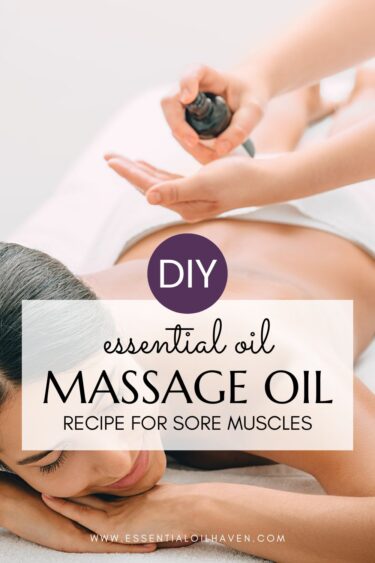 In this article, I will show you how to make a massage oil for sore muscles, specifically designed to kick muscle pains, aches and tensions to the curb.
In this article, I will show you how to make a massage oil for sore muscles, specifically designed to kick muscle pains, aches and tensions to the curb.
I have a workout class every Wednesday morning. And honestly, I’m usually sore for the next 4 days.
I suppose I “work hard” during workout class.
This post contains affiliate links, which means if you make a purchase through these links, I may receive a small commission at no extra cost to you. Read my full disclosure policy here.
Essential oils can be very beneficial for relieving sore muscles. The oils’ anti-inflammatory properties support your body’s natural healing process.
Massage Oil Recipe for Sore Muscles
Here is a simple DIY massage oil recipe for muscle recovery. It uses four essential oils and one carrier oil.
Together, these essential oils help to relax muscles, alleviate muscle tension, and promote pain relief for stiff muscles.
If you wish to substitute any given oil, I recommend you pick another one from this list of best essential oils for sore muscles here.
Ingredients
- 2 oz (60 mL) Almond oil
- 8 drops Lavender essential oil
- 2 drops Peppermint essential oil
- 4 drops Eucalyptus essential oil
- 6 drops Rosemary essential oil
Instructions
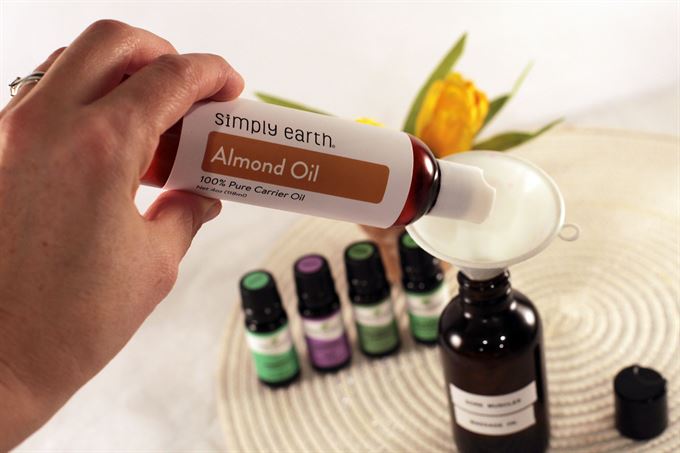
Start with Almond Oil as your Massage Oil Base
- Get a 2 oz (60 ml) dark amber glass glass bottle with a tight-fitting lid.
- Carefully pour the Almond oil into the glass bottle, filling it almost to the top.
- Add the drops of essential oils into the bottle one by one.
- Label your bottle.
- Secure the lid tightly and shake the bottle gently to blend the oils together.
- Let the blend sit for a 10-15 minutes to allow the oils to synergize and enhance the aroma.
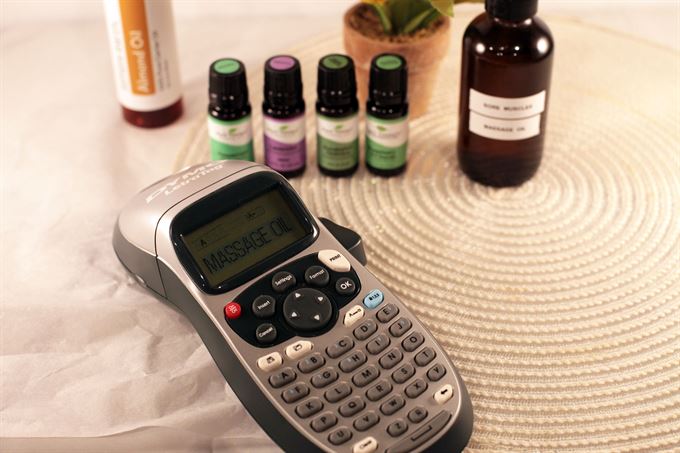
I use a label maker to easily label my DIY recipe bottles.
Your DIY muscle massage oil is now ready to use!
To apply the massage oil, pour a small amount into your palm and warm it up by rubbing your hands together. Massage the oil into the affected area using gentle, circular motions, applying light to moderate pressure as desired.
- NOTE: Remember to perform a patch test before using the oil on a larger area of your skin and discontinue use if any irritation occurs.
- ALSO: This recipe is NOT kid safe. The essential oils use are not recommended for children under 10.
Allergies and Skin Sensitivities
Before you use your DIY massage oil all over your own (or your partner’s) body, it’s important to remember that essential oils are highly concentrated and should be used with caution.
Always perform a patch test before applying it more liberally to your skin.
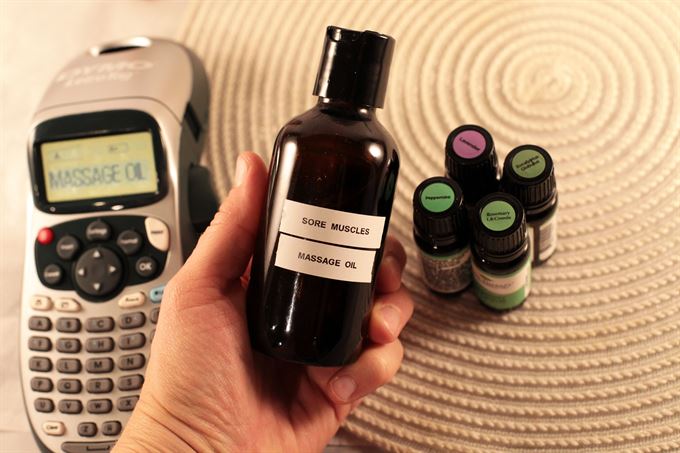
Make sure to test your homemade massage oil on a small area of skin first.
If you have any underlying health conditions or concerns, consult with a healthcare professional or Certified Aromatherapist.
In my recipe, the ratio of carrier oils to essential oil is 1%. This is a dilution rate that’s regarded generally as safe. It also works for sensitive skin or if you are elderly.
If you’d like to make your oil more potent, please consult my dilution rates guide HERE and adjust the number of drops used accordingly. For example, if you use double the amount of essential oils to the same amount of carrier oil, the dilution rate would be 2%.
Frequently Asked Questions
Can massage oils be harmful to my skin?
When used properly, massage oils are generally safe for the skin. However, some individuals may have allergies or sensitivities to certain oils or their components. It’s important to perform a patch test, use high-quality oils, dilute them properly, and consider individual sensitivities to minimize the risk of any potential harm or skin reactions.
What is the difference between oil and lotion-based massage oils?
The primary difference is in their texture and composition. Oil-based massage oils typically consist of carrier oils blended with essential oils, offering a greasier texture that provides lubrication for longer massage sessions. On the other hand, lotion-based massage oils include water, emulsifiers, and the oils, thus creating a lighter, non-greasy texture that absorbs more easily into the skin.
Lotion-based oils are often preferred for shorter massages or when a less oily residue is desired, while oil-based oils are favored for longer, more luxurious massages. Ultimately, the choice between the two depends on personal preference and the specific needs of the massage session.
What type of oil do massage therapists use?
Typically, massage therapists will use plain, scent free oils as to not trigger any patient sensitivities to smells or tastes. While there is no standard oil used by all massage therapists, some commonly used oils include Sweet Almond oil, Jojoba oil, Coconut oil, Grapeseed oil, or Apricot Kernel oil.
Some massage therapists may also use lotions, gels, or creams instead of oils, depending on their preferred techniques or the needs of their clients.
Final Thoughts
Making a massage oil for stiff muscles can be a fun and enjoyable experience that allows you to customize your essential oil blend according to your preferences and needs. It gives you the opportunity to explore different essential oils and carrier oils, creating a unique scent and therapeutic effect.
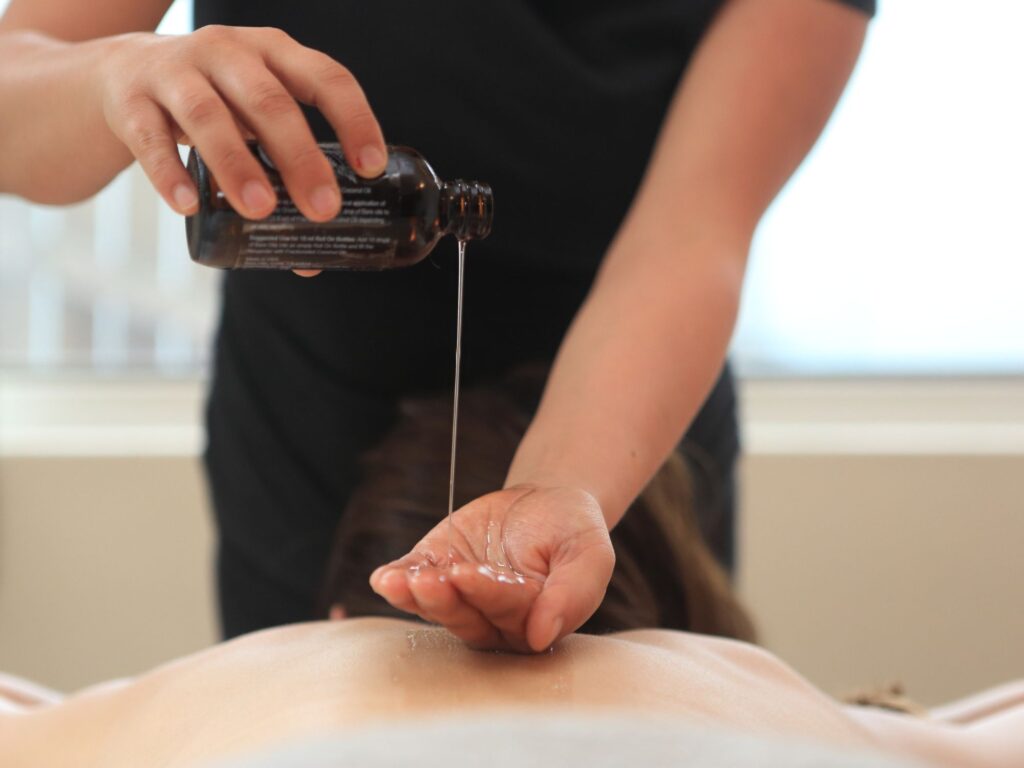
Natural massage oils are generally safe to use on skin.
Also, DIY massage oils are often more cost-effective compared to pre-made ones, saving you money in the long run. With the right ingredients and proper dilution, creating a personalized sore muscle massage oil is worth a try to experience the soothing and relaxing benefits of aromatherapy in a natural and affordable way.
If you are looking for more recipes, head over here for 15 more DIY massage oil recipes for all occasions.
Resources
- How to Give a Massage (Wikihow.com)
Pin this Recipe for Later
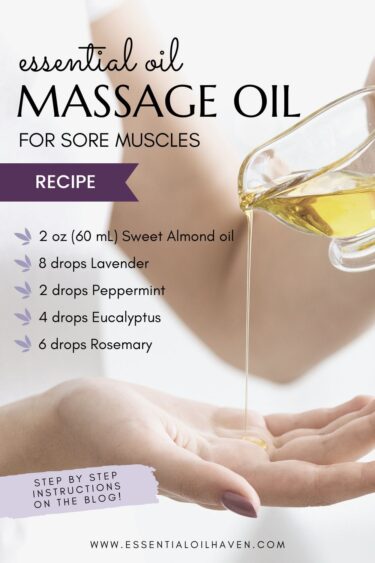

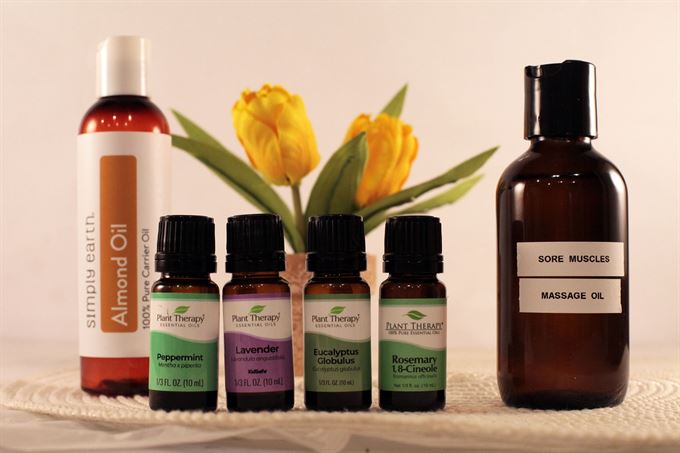


Leave a Reply